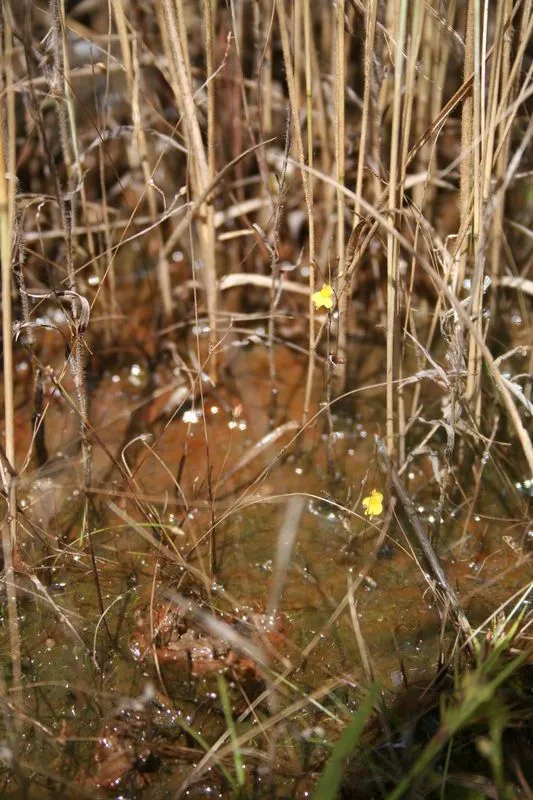
Author: L.
Bibliography: Sp. Pl.: 18 (1753)
Year: 1753
Status: accepted
Rank: species
Genus: Utricularia
Vegetable: False
Observations: Tropics & Subtropics to N. America
The Zigzag bladderwort, known scientifically as Utricularia subulata, is a fascinating and widely spread carnivorous plant. Recognized for its intricate and effective trapping mechanism, this plant belongs to the Lentibulariaceae family and was first described by the renowned botanist Carl Linnaeus in his seminal work “Species Plantarum” in 1753.
Characterized by its small size and delicate appearance, the Zigzag bladderwort displays a unique blend of floral and vegetative qualities. The plant derives its common name from the irregular, zigzag or meandering growth pattern of its stems, which sets it apart from many other Utricularia species. The flowers, which are typically yellow and minuscule, bloom sporadically and are delicately suspended on slender stalks, adding to the charm of this plant.
Utricularia subulata is not confined to a narrow ecological niche; it exhibits a remarkable adaptability across a wide range of environments. Its distribution spans from the moist, tropical regions to the more temperate subtropical zones, extending as far as North America. This adaptability underscores the plant’s resilience and its ability to thrive in varied climatic conditions.
A distinctive feature of the Zigzag bladderwort is its carnivorous trapping mechanism. The plant possesses small, bladder-like structures that function to capture and digest tiny aquatic or soil-dwelling organisms. These bladders operate through a sophisticated, yet minute, vacuum mechanism that swiftly traps prey once it triggers sensitive hairs on the bladder’s entrance. This nutritional strategy allows the plant to supplement the poor nutrient availability in its often marginal environments.
The intriguing life cycle and structural characteristics of Utricularia subulata make it a subject of interest among botanists and plant enthusiasts alike. Whether observed in its natural habitat or cultivated in specialized collections, the Zigzag bladderwort remains a remarkable example of nature’s ingenuity in plant adaptation and survival strategies.
Eng: zigzag bladderwort, subulate bladderwort, tiny bladderwort
Fra: utriculaire à feuilles subulées, slender bladderwort
En: Zigzag bladderwort, Subulate bladderwort, Tiny bladderwort, Slender bladderwort
Zh: 尖叶狸藻, 尖葉狸藻
Fr: Utriculaire à feuilles subulées, Slender bladderwort, Utriculaire gibbeuse
Zh-hant: 尖葉狸藻
© copyright of the Board of Trustees of the Royal Botanic Gardens, Kew.
© copyright of the Board of Trustees of the Royal Botanic Gardens, Kew.
© copyright of the Board of Trustees of the Royal Botanic Gardens, Kew.
Taken Apr 3, 2020 by Mary Mary Heyman (cc-by-sa)
Taken Jan 1, 1900 by EOL − Bart Wursten (cc-by-nc)
Taken Sep 24, 2012 by EOL − Ken-ichi Ueda (cc-by-nc)
Taken Dec 4, 2021 by Tristan Jaton-Maria (cc-by-sa)
Taken May 30, 2012 by EOL − Don Loarie (cc-by)
Taken Jan 1, 1900 by EOL − Marco Schmidt (cc-by-nc-sa)
Taken Jan 1, 1900 by EOL − Marco Schmidt (cc-by-nc-sa)
Taken Jan 1, 1900 by EOL − Marco Schmidt (cc-by-nc-sa)
Taken Jun 3, 2009 by EOL − Barry Rice (cc-by-nc-sa)
Taken Jun 3, 2009 by EOL − Barry Rice (cc-by-nc-sa)
Taken Jul 8, 2022 by blomfluga (cc-by-sa)
Growth habit>: Forb/herb
Family: Myrtaceae Author: (F.Muell.) K.D.Hill & L.A.S.Johnson Bibliography: Telopea 6: 402 (1995) Year: 1995 Status:…
Family: Rubiaceae Author: Pierre ex A.Froehner Bibliography: Notizbl. Bot. Gart. Berlin-Dahlem 1: 237 (1897) Year:…
Family: Sapindaceae Author: Koidz. Bibliography: J. Coll. Sci. Imp. Univ. Tokyo 32(1): 38 (1911) Year:…
Family: Asteraceae Author: A.Gray Bibliography: Pacif. Railr. Rep.: 107 (1857) Year: 1857 Status: accepted Rank:…
Family: Fabaceae Author: Medik. Bibliography: Vorles. Churpfälz. Phys.-Ökon. Ges. 2: 398 (1787) Year: 1787 Status:…
Family: Aspleniaceae Author: (Cav.) Alston Bibliography: Bull. Misc. Inform. Kew 1932: 309 (1932) Year: 1932…